
Puzzle Bobble, internationally known as Bust-A-Move, is a 1994 tile-matching puzzle arcade game developed and published by Taito. It is based on the 1986 arcade game Bubble Bobble, featuring characters and themes from that game. Its characteristically cute Japanese animation and music, along with its play mechanics and level designs, made it successful as an arcade title and spawned several sequels and ports to home gaming systems.
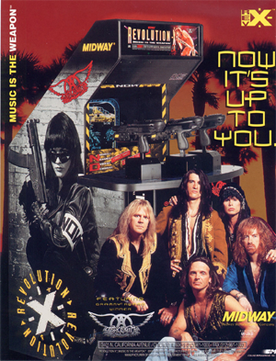
Revolution X is a shooting gallery video game developed by Midway and released in arcades in 1994. The gameplay is similar to Midway's earlier Terminator 2: Judgment Day, but is themed around the band Aerosmith. The oppressive New Order Nation regime and their leader Helga have abducted Aerosmith, and players use a mounted gun to control onscreen crosshairs and shoot enemies. The members of Aerosmith are hidden throughout the game's international locales and must be found in order to receive the game's true ending.

Primal Rage is a fighting game developed and released by Atari Games to arcades in the year 1994. The game takes place on a post-apocalyptic version of Earth called "Urth". Players control one of seven large beasts that battle each other to determine the planet's fate. Matches feature many of the conventions of fighting games from the era, including special moves and gory finishing maneuvers. Ports were released for home consoles and personal computers. Efforts to perfectly emulate the arcade original have been unsuccessful due to the use of an unusual copy protection method. Toys, comics, a novel and other merchandise tie-ins were produced. The game sold more than 1.5 million copies.

Madden NFL '96 is a football video game designed for the 1995 NFL season, licensed by the NFL. Publisher Electronic Arts intended for it to be the first licensed NFL game for the PlayStation, but the PlayStation version was delayed and ultimately cancelled, with the game being published only for previous-generation consoles, PCs, and handhelds. Compared to previous Madden NFL games, the AI has been boosted and can now hurry in two-minute drill situations, spike the ball, and cover the receivers with better efficiency. In addition to the 16-bit console and portable versions, a DOS version was also released under the title of Madden NFL Football: Limited Edition in 1996.

PGA Tour Golf is a golf video game and the first in the PGA Tour game series. It was developed by Sterling Silver Software and released in 1990, for MS-DOS. It was initially published by Electronic Arts, which subsequently released versions of the game for Sega Genesis and Amiga in 1991, followed by a version for the SNES in 1992. By 1994, Tengen had published versions for Sega's Master System and Game Gear consoles. PGA Tour Golf received generally positive reviews for its realism, sound, and camera. Several critics considered the computer versions to be the best golf game available at the time of its release. It was followed by PGA Tour Golf II.

Batman Forever is a beat 'em up video game based on the movie of the same name. Though released by the same publisher at roughly the same time, it is an entirely different game from Batman Forever: The Arcade Game. The game was followed by Batman & Robin in 1998, itself based on the movie of the same name.
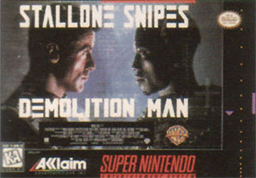
Demolition Man is a pair of action video games based on the film of the same name. Acclaim Entertainment published the 16-bit version, which features run and gun gameplay, for the Super NES, Sega Genesis and Sega CD. Virgin Interactive released a completely different game for the 3DO that combined several distinct gameplay styles. In both games, the player controls John Spartan, the main character from the film, as he attempts to find and defeat his nemesis, Simon Phoenix.
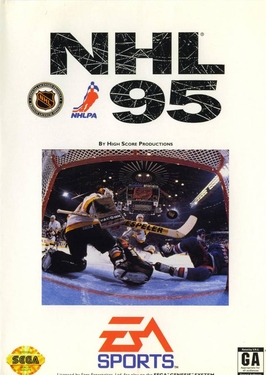
NHL 95 is an ice hockey video game developed by Electronic Arts Canada. It was released in 1994 for the Super Nintendo Entertainment System and the Sega Genesis. The team rosters and player attributes in the game reflect that of the 1994–95 season.

NHL 96 is a 1995 sports video game developed by EA Tiburon for the SNES, High Score Productions for the Sega Genesis, EA Canada for DOS, and Probe Entertainment for the Game Boy. EA Sports published all versions of the game except the Game Boy version, which was published by THQ. The game is based on the sport of ice hockey and puts the player in control of a hockey team in modes of play such as exhibitions, seasons and playoffs. It is the fifth installment in the NHL game series.

NHL 97 is an ice hockey video game by EA Sports. It was released in 1996 and was the successor to NHL 96. It is the sixth installment of the NHL series and the first to be released on both PlayStation and Saturn. A Panasonic M2 version was in development and slated to be one of the launch titles for it, but never happened due to the cancellation of the system.

Madden NFL 97 is a football video game released in 1996. It was the first multiplatform Madden game released for the 32-bit consoles, being released on both the PlayStation and Sega Saturn. 16-bit versions were also made for the established Super NES and Genesis platforms, as well as a portable version for the Game Boy.
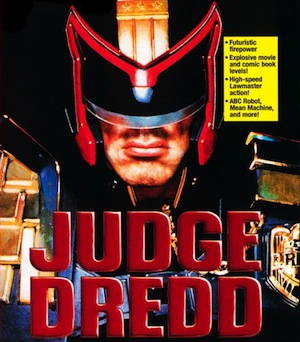
Judge Dredd is a side-view action video game released for the Super NES, Mega Drive/Genesis, Game Gear and Game Boy originally released in 1995. The game is based on the 1995 film Judge Dredd, which was itself an adaptation of the Judge Dredd strip from 2000AD.
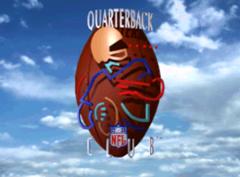
NFL Quarterback Club is an American football video game for multiple platforms that features quarterbacks from the NFL. It is the first game in Acclaim Entertainment's NFL Quarterback Club series.

NBA Live 96 is the second installment of the NBA Live video game series published by EA Sports and released on November 30, 1995. The PC and PlayStation covers feature Shaquille O'Neal of the Orlando Magic, while the Super Nintendo Entertainment System, Sega Genesis and European PlayStation box covers feature a photo of the tip-off to Game 1 of the 1995 NBA Finals. PlayStation and PC versions are the first games in the series to feature 3D-rendered courts, allowing for multiple camera angles using EA's "Virtual Stadium" technology, which is also used for FIFA Soccer 96. On-court player graphics remain 2D sprites. It is also the first NBA Live game released for the PlayStation and the only game for the Game Boy. NBA Live 96 is followed by NBA Live 97.

BattleSport is a 1996 futuristic sports video game developed by Cyclone Studios. It was originally published by Studio 3DO exclusively for their 3DO Interactive Multiplayer in 1996, but after the 3DO was discontinued BattleSport was published for other systems by Acclaim Entertainment. It was released for Windows and PlayStation in North America on June 30, 1997, and in Europe on August 1, 1997. It also saw a US only release on the Saturn.

FIFA Soccer 96 is a football simulation video game developed by Extended Play Productions and released by Electronic Arts in 1995. It was released for the Mega Drive/Genesis, Sega Saturn, Sega 32X, Game Gear, PlayStation, Super Nintendo Entertainment System, and MS-DOS compatible operating systems.
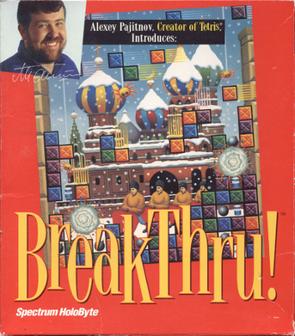
BreakThru! is a tile-matching puzzle video game released for the Windows and MS-DOS in 1994. It was created by Steve Fry for the Japanese company ZOO Corporation and published by Spectrum HoloByte, for the North American market.

NFL Quarterback Club 96 is an American football video game released in December 1995. The game was released on the Sega Saturn, Sega Genesis, Game Boy, Sega Game Gear, DOS, and Super Nintendo Entertainment System. The game's cover features San Francisco 49ers quarterback Steve Young passing while being tackled by Chicago Bears defensive linemen Chris Zorich and Albert Fontenot. The Saturn, Genesis, SNES and DOS versions were developed by Iguana Entertainment, while the Game Boy and Game Gear edition was developed by Condor Inc.

PGA Tour Golf III is a sports video game developed by American studio Hitmen Productions and published by EA Sports for Sega Genesis in 1994.

Road Rash is a 1994 racing and vehicular combat video game originally published by Electronic Arts (EA) for the 3DO Interactive Multiplayer. A version for the Sega CD was developed simultaneously and released in 1995 to act as a "bridge" between the 3DO version and the Sega Genesis title Road Rash 3, and the game was subsequently ported to the PlayStation, Sega Saturn, and Microsoft Windows in 1996. The game is the third installment in the Road Rash series, and is centered around a series of motorcycle races throughout California that the player must win to advance to higher-difficulty races, while engaging in unarmed and armed combat to hinder the other racers.




















